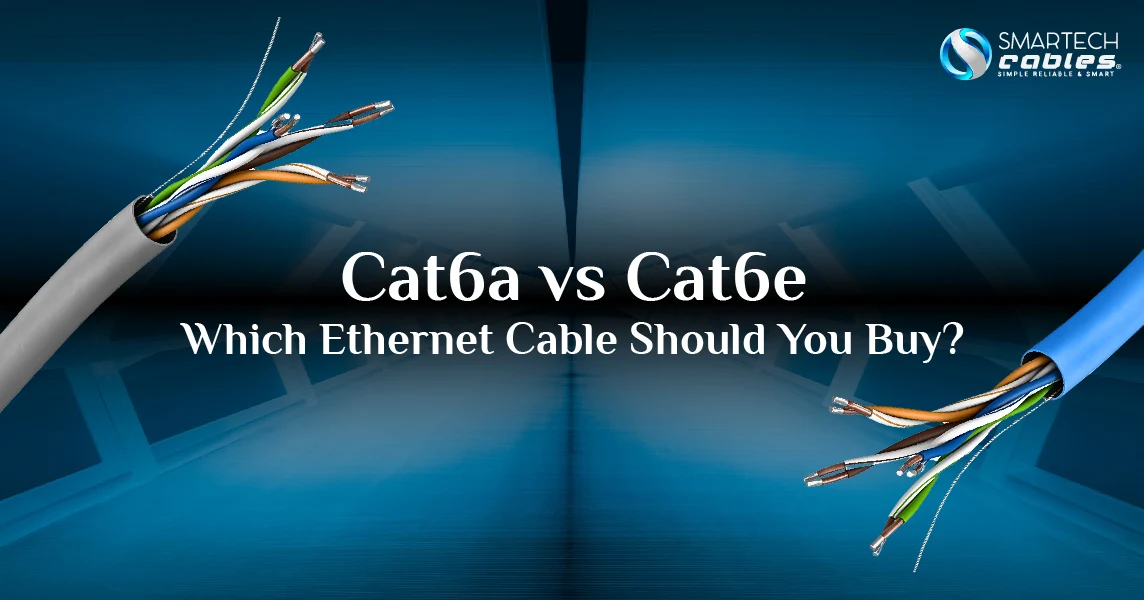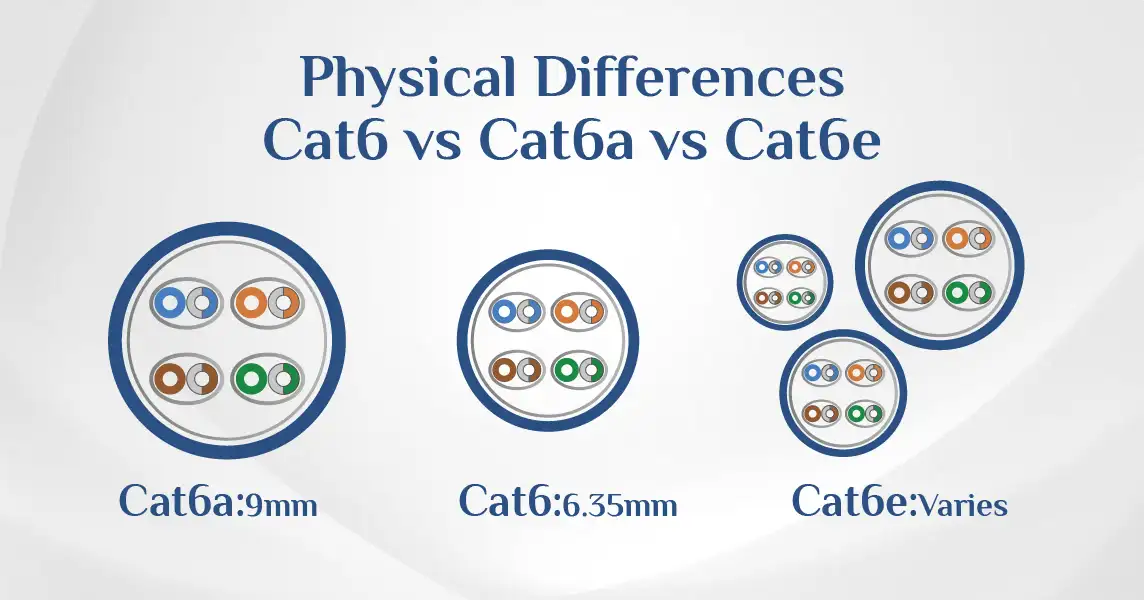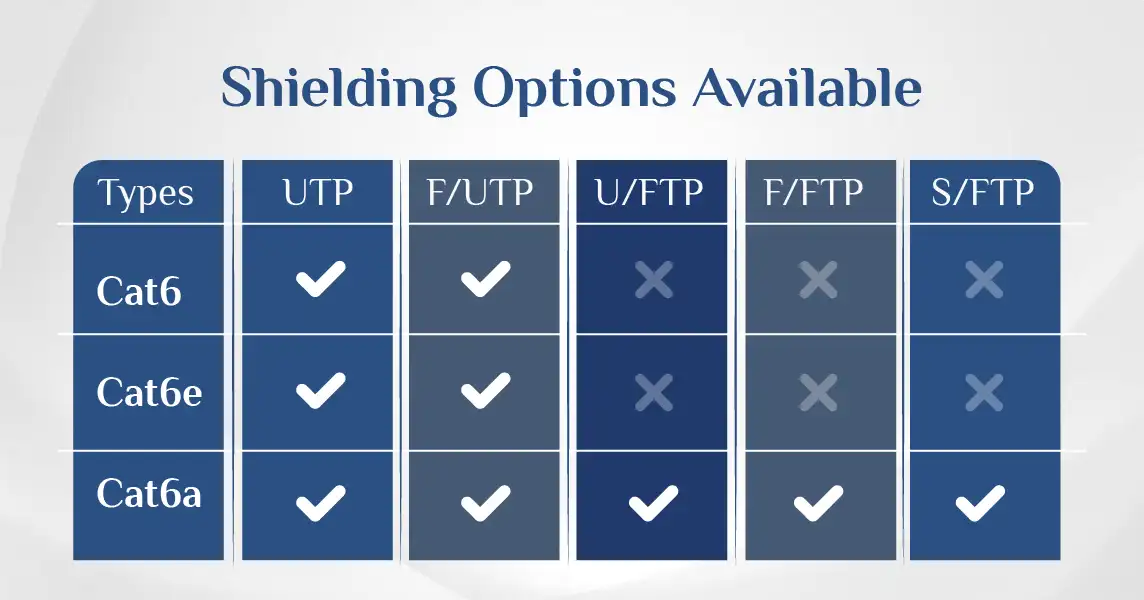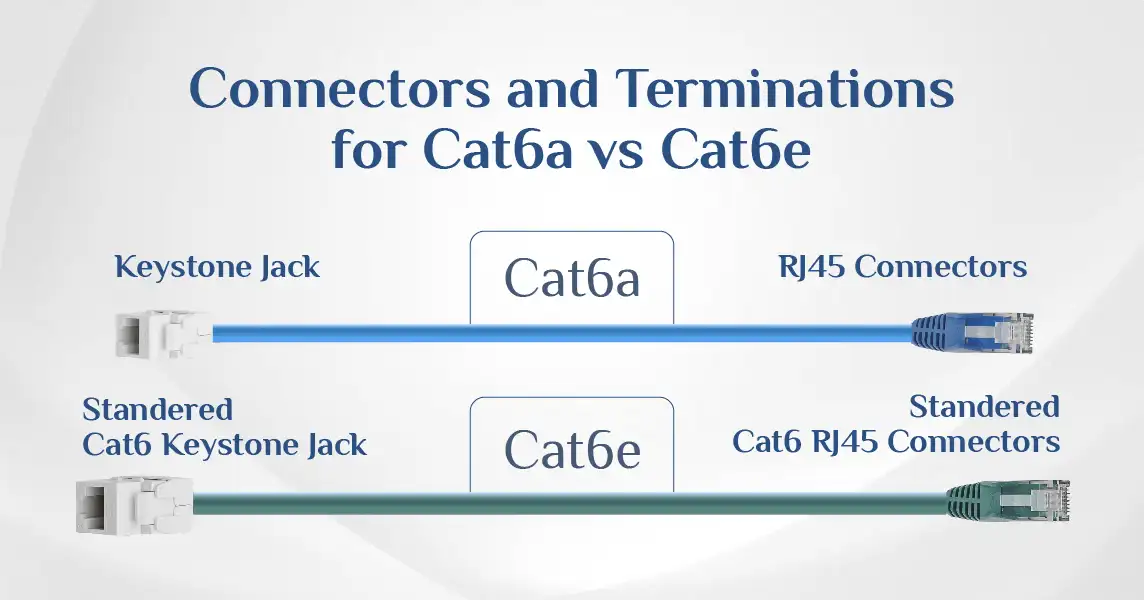Cat6a vs Cat6e: Which Ethernet Cable Should You Buy?

Are you confused about choosing between Cat 6a and Cat 6e network cables for your home or office? You're not alone! Whether you're setting up a new network or upgrading your existing Ethernet infrastructure, understanding the differences between Cat6a vs Cat6e cable types is crucial for making the right choice. That's why many people today are comparing Cat 6a vs Cat 6e cables. These cables look similar, but they have key differences that affect speed, distance, and performance. If you've been searching for the best option between Cat6 vs Cat6e vs Cat6a, or trying to understand the difference between Cat 6 and Cat 6e, you're in the right place.
So, what is a Cat6e cable? Is it a real standard like Cat6a, or more of an unofficial upgrade to Cat6? What are the Cat6e cable specifications, speed limits, cable diameter, and maximum length? How does a Cat6e Ethernet cable compare to a Cat6a Ethernet cable when it comes to shielding, interference protection, and speed?
In this guide, we’ll break down everything you need to know, from Cat6e UTP and STP cables to Cat6e keystone jacks and RJ45 connectors.
What Are Category (CAT) Ethernet Cables?
Before discussing the specifics of Cat6a vs. Cat6e cables, let's refresh ourselves on what category cables actually are.
Category (CAT) cables are twisted pair cables designed for computer networking. The "category" classification refers to specifications for crosstalk and noise reduction. As technology has advanced, these standards have evolved to support faster data transmission speeds and longer cable runs. It starts from Cat5 to Cat5e, Cat,6 and then the latest Cat8
Each new generation of different Ethernet cables improves upon the previous one, with upgrades to bandwidth, maximum length, and transmission speed. Organizations like the Telecommunications Industry Association (TIA) and the Electronic Industries Alliance (EIA) set the standards.
The Truth About Cat6e Cable
Here's something that might surprise you: Cat6e is not an officially recognized standard by TIA/EIA. And that is true. But you still might see cables marketed as "Cat6e" or "Category 6 Enhanced" in stores or online; this designation isn't based on any official industry standard.
So, what exactly is Cat6e? Essentially, it's a marketing term used by some manufacturers to describe cables that perform better than standard Cat6 but don't quite meet the specifications of Cat6a. These cables typically offer bandwidth somewhere between the 250 MHz of Cat6 and the 500 MHz of Cat6a.
Cat6e is the middle child between Cat6 and Cat6a, and not officially recognized, but is trying to carve out its own identity in the marketplace. When shopping for Ethernet cables, it's important to know that the performance of products labeled as Cat6e can vary from one manufacturer to another, precisely because there's no standard definition.
Cat6a Cable: The Advanced Standard
Cat6a (Category 6 Augmented) is the next official step up from Cat6 in the Ethernet cable hierarchy. This TIA/EIA recognized standard supports 10 Gbps speeds over the full 100-meter distance, double the bandwidth of Cat6 at 500 MHz, and features significantly improved specifications for crosstalk, particularly alien crosstalk (interference from adjacent cables).
The physical construction of Cat6a cables is noticeably different from Cat6. They're typically thicker and heavier due to additional insulation and shielding materials designed to reduce alien crosstalk. This additional bulk makes Cat6a cables less flexible and potentially more challenging to install, especially in tight spaces.
Cat6a cables are ideal for future-proofing networks, especially in environments with high electromagnetic interference (EMI) or where 10 Gbps speeds are required over longer distances.
Direct Comparison: Cat6e vs Cat6a
Now let's put Cat6a and what's marketed as Cat6e head-to-head to see how they compare:
|
Specification |
Cat6a |
Cat6e (marketed) |
Cat6 |
|
Official Standard |
Yes (TIA/EIA) |
No |
Yes (TIA/EIA) |
|
Maximum Bandwidth |
500 MHz |
Varies (250-500 MHz) |
250 MHz |
|
Speed at 100m |
10 Gbps |
1-10 Gbps (varies) |
1 Gbps |
|
Speed at 55m |
10 Gbps |
10 Gbps |
10 Gbps |
|
Alien Crosstalk Protection |
High |
Medium |
Lower |
|
Typical Cable Diameter |
Larger |
Medium |
Smaller |
|
Shielding Options |
UTP, F/UTP, U/FTP, F/FTP |
UTP, F/UTP |
UTP, F/UTP |
|
Relative Cost |
Higher |
Medium |
Lower |
As you can see from this Cat6a vs Cat6e comparison table, Cat6a offers standardized performance specifications, while Cat6e specs can vary between manufacturers since there's no official standard. This inconsistency is one of the main reasons network professionals often recommend sticking with officially recognized standards like Cat6 or Cat6a.
Physical Differences Between CAT 6A vs CAT 6E
When comparing Cat6a vs Cat6e cables, the physical differences can be quite noticeable. Cat6a cables are typically thicker due to additional insulation and shielding. This added bulk helps reduce alien crosstalk, which becomes increasingly important at higher frequencies.
The diameter of Cat6a cable is generally around 0.354 inches (9mm), while standard Cat6 is about 0.250 inches (6.35mm). What's marketed as Cat6e usually falls somewhere in between these dimensions, though exact measurements vary by manufacturer.

Shielding Options Explained
Understanding shielding options is crucial for selecting the right cable for your environment when discussing Cat6a vs. Cat6e and Cat6 cables.
Unshielded Twisted Pair (UTP) is the most common and least expensive option. These cables rely solely on the twisting of wire pairs to reduce interference. UTP works well in environments with minimal electromagnetic interference (EMI).
Shielded Twisted Pair (STP) includes additional shielding to protect against EMI. There are several types:
- F/UTP (Foiled UTP): An overall foil shield around all four pairs
- U/FTP (Unshielded/Foiled Twisted Pair): Individual foil shields around each pair, but no overall shield
- F/FTP (Foiled/Foiled Twisted Pair): Individual foil shields around each pair, plus an overall foil shield
- S/FTP (Screened/Foiled Twisted Pair): Individual foil shields around each pair plus an overall braided shield
Cat6a is available in all these shielding configurations, making it suitable for virtually any environment. What's sold as Cat6e typically comes in UTP and F/UTP varieties, though this varies by manufacturer. Standard Cat6 is most commonly available as UTP or F/UTP.

In high-interference environments like industrial settings, healthcare facilities, or areas with many electrical devices, the superior shielding options available for Cat6a provide a significant advantage over both Cat6 and marketed Cat6e cables.
|
Cable Type |
Shielding Options Available |
Best Use Case |
|
Cat6 |
UTP, F/UTP |
Environments with minimal EMI (e.g., home or small office settings). |
|
Cat6e |
UTP, F/UTP (varies by manufacturer) |
Similar to Cat6, but performance claims vary; suitable for low to moderate EMI environments. |
|
Cat6a |
UTP, F/UTP, U/FTP, F/FTP, S/FTP |
High-interference environments (e.g., industrial settings, healthcare facilities, areas with many electrical devices). |
Performance in Challenging Environments
When comparing Cat6e vs Cat6a cable performance in difficult environments, Cat6a holds a clear advantage due to its standardized specifications and superior construction.
Temperature Tolerance
Cat6a cables typically offer wider temperature tolerances, with many rated for operation between -20°C to 75°C (-4°F to 167°F). What's marketed as Cat6e generally has temperature ratings similar to standard Cat6, which might have a narrower range depending on the manufacturer.
Electrical Interference Resistance
Cat6a's improved shielding and twist density provide superior resistance to:
- Power line interference
- Motor and transformer noise
- Cross-talk from adjacent cables
- Wireless signal interference
This makes Cat6a the preferred choice for installations near electrical equipment, elevators, HVAC systems, or other sources of electromagnetic interference.
Outdoor and Industrial Applications
For outdoor or industrial installations, look for cables specifically rated for these environments. Cat6a is more commonly available with:
- UV-resistant jackets
- Waterproof or water-resistant constructions
- Oil and chemical resistant options
- Direct burial ratings
These specialized versions maintain the performance specifications of standard Cat6a while adding environmental protections. Similar specialized versions of what's marketed as Cat6e may be harder to find due to the non-standardized nature of the classification.
Connectors and Terminations for Cat6a vs Cat6e
The choice of connectors and termination methods significantly impacts network performance, especially when comparing Cat6a vs Cat6e implementations.
RJ45 Connectors
While all these cable types use the familiar RJ45 connector, there are important differences:
- Cat6a RJ45 connectors are specifically designed to maintain the cable's performance specifications. They often feature improved internal wiring management, better shielding, and more robust construction. Look for connectors specifically rated for Cat6a.
- Connectors for what's marketed as Cat6e typically use standard Cat6 RJ45 connectors, though some manufacturers may offer "enhanced" versions claiming improved performance.
Keystone Jacks and Wall Plates
For permanent installations, the choice of keystone jacks is equally important:
- Cat6a keystone jacks are designed with additional shielding and precise wire management to maintain the 500 MHz bandwidth specification. They're often larger and require more space in wall boxes.
- Jacks for what's marketed as Cat6e vary by manufacturer but generally follow Cat6 designs with potential enhancements.

Termination Standards
Both TIA/EIA 568A and 568B wiring standards are acceptable for all these cable types, but consistency is crucial. Mixing standards within a single link will cause failures. The choice between T568A and T568B doesn't affect performance; it's simply a matter of wiring consistency.
Testing and Certification
After installation, proper testing is essential:
- Cat6a requires testing to 500 MHz with alien crosstalk measurements
- What's marketed as Cat6e lacks standardized testing parameters
- Cat6 requires testing to 250 MHz
Conclusion
For most new installations today, Cat6a represents the best combination of current performance, future-proofing, and standardized specifications. The cost premium over standard Cat6 or what's marketed as Cat6e is typically justified by the longer useful life and higher performance capacity.
For existing Cat6 or Cat6e installations that are performing adequately, there's no pressing need to upgrade unless you have specific high-bandwidth requirements or are experiencing performance issues.
When making your decision, remember that network cabling typically remains in place for many years, making it one of the most important long-term infrastructure investments in your network. Choosing the right cable category today can save significant expense and disruption down the road.
Common Myths and Misconceptions
When discussing Cat6a vs Cat6e cables, several myths and misconceptions often arise:
Cat6e is the same as Cat6a
Reality: Cat6e is not an officially recognized standard and doesn't have standardized performance specifications like Cat6a. The performance of cables marketed as Cat6e can vary significantly between manufacturers.
All Cat6 cables are the same
Reality: There can be significant quality differences between Cat6 cables from different manufacturers. Factors like copper quality, insulation materials, twist rates, and overall construction quality affect performance even within the same nominal category.
Higher category always means better performance
Reality: While higher categories generally offer better performance specifications, actual performance depends on proper installation, quality terminations, and compatible network equipment. A properly installed Cat6 system will outperform a poorly installed Cat6a system.
Shielded cable is always better than unshielded
Reality: Shielded cable only provides advantages in environments with significant electromagnetic interference. Improperly installed shielding can actually degrade performance by creating ground loops. In many residential and standard office environments, unshielded cable performs perfectly well.
You can't tell the difference between cable categories in real-world use
Reality: While typical internet connections (100-500 Mbps) won't saturate even CAT 5e capacity, internal network activities like file transfers, backup operations, and video streaming can benefit significantly from higher-category cables, especially as 10 Gbps networking equipment becomes more common.


